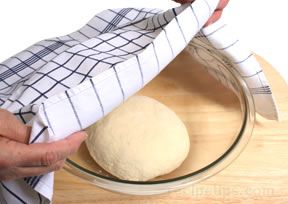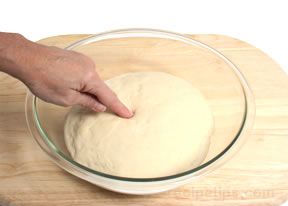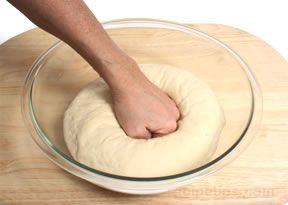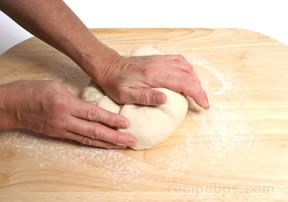| After the bread dough has been kneaded, it must be allowed to rest in order for the yeast to continue with the fermentation. The fermentation produces carbon dioxide gas, which becomes trapped within the dough, resulting in the rising action that is necessary to develop the texture and flavor of the final product. Described below are steps that are typical for rising and punching, but remember to follow the instructions in the recipe as there may be differences. Some breads may require two or more cycles of rising and punching before the dough is shaped and allowed to rise for the final time. |
| Many bread recipes call for the dough to be placed in a large bowl that has been lightly oiled. A large glass bowl or stoneware bowl work the best. The bowl should be covered with a clean, damp kitchen towel or plastic wrap and placed in a draft-free location that is of a constant temperature. A temperature range of 75º to 80ºF is often best for bakers who require the dough to rise properly, but at a quicker rate. A cooler temperature will cause the dough to rise more slowly, but the flavor and texture of the bread often improves because of this. In fact, the dough can be allowed to rise in the refrigerator if it is placed in a glass bowl, covered with plastic wrap, and left for 8 to 10 hours. After it has fully risen, the dough should be allowed to rest at room temperature for two hours. |

|
| The dough for most bread recipes should be allowed to rise until about doubled in size, but follow the recipe for the exact instructions because some bread recipes may call for the dough to rise until more than doubled in size. Many types of bread dough require one to two hours for the first rising, but the temperature of the dough and the quantity of yeast will affect the required time. The rising time is also affected by dough that contains enrichments, such as butter and eggs, which lengthen the time required for the dough to rise adequately. |
 |
| The dough is ready when air bubbles have formed on the surface of the dough. An easy method to determine if the dough has risen sufficiently is to simply press on the dough with a finger. If the dough springs back quickly, it is an indication that the dough has not risen sufficiently, but if the indentation remains, the dough has properly risen. |
 |
When the dough has risen fully, it needs to be deflated. This is accomplished by punching the dough in the bowl. Punching is necessary because the carbon dioxide gas that has formed in the dough during fermentation requires redistribution. The yeast also becomes revived to continue the rising process.
|
 |
| After punching the dough, it should be turned out onto a floured work surface and kneaded for one or two minutes. The punching and additional kneading steps are important because skipping them may cause large holes to form in the bread. After punching and kneading, the dough should be allowed to rest for several minutes before proceeding. |
 | |

